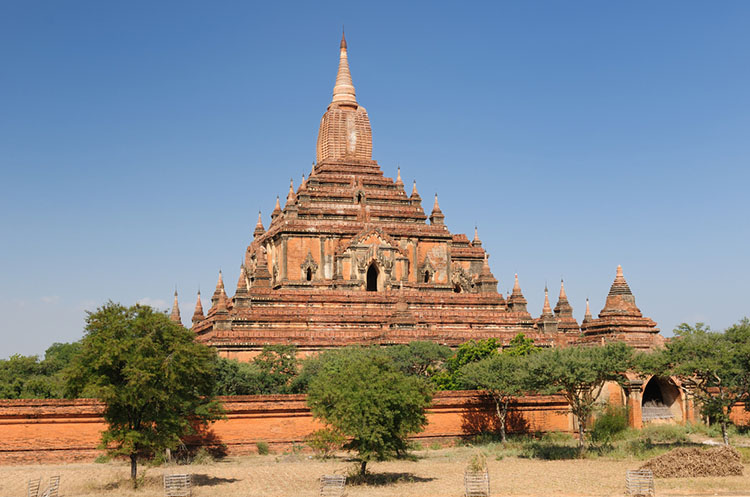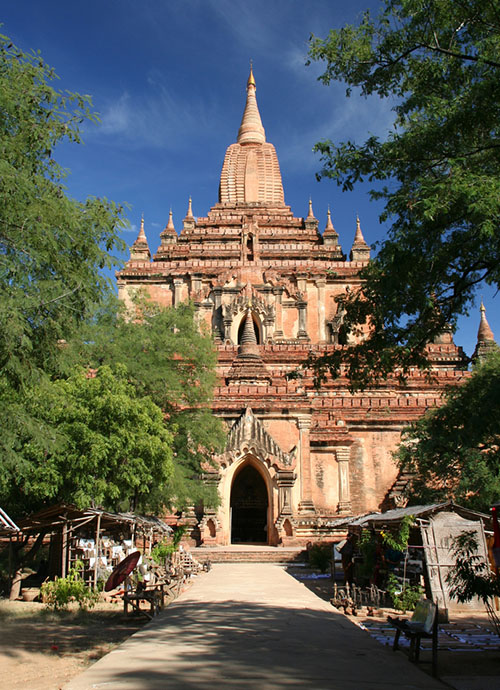
Sulamani temple
Large, very elegant two storey monument
Two storey
The Sulamani is a large, very elegant multi storey structure from the late Bagan period. The temple was built during the reign of King Narapatisithu, a very prosperous time in Bagan. During his long reign several of Bagan’s most impressive monuments were built, such as the Dhammayazika and the Gawdawpalin temple.
Origin of the temple’s name
An inscribed stone in the North porch of the temple tells that King Narapatisithu found a small ruby at the spot where the Sulamani temple was later erected, hence the name of the temple, which means small ruby.
Architecture of the Sulamani
The architectural style has many similarities with that of the Htilominlo temple, which was built a few decades later. The Sulamani is a two storey structure with a square layout. The large first floor is topped with three receding terraces. The upper floor which is much smaller is topped with another four receding terraces. The corners of both lower and upper terraces contain smaller spires.
The top of the Sulamani comprises of a shikhara, a tower structure originating from North India. Unlike the one of the Ananda temple, the shikhara is not gilded. On top of that is the hti, a spire ornament shaped like an umbrella.
The temple has entrance porches on all four sides. The Eastern porch which is the main entrance protrudes further out from the structure than the others. Apart from this, the structure is symmetrical.

Jataka tales plaques
The Sulamani’s base and terraces contain beautiful glazed terracotta plaques with depictions of Jataka tales, the stories about the previous lives of the Buddha. It was customary for the most important and largest temples in Bagan to have a set of plaques with Jataka tales, of which there are 547 in total, in order to educate the people about Buddhism.
The pediments over the entrance doors and windows show finely carved stucco decorations.
Frescoes and murals
The ground floor contains Buddha images on each of its four sides. The corridor surrounding the lower cube contains frescoes and murals from various eras. They depict scenes from the life of the Buddha as well as various mythological animals like Naga snakes and Makara sea creatures.
The niches in the wall of the corridors surrounding the cubes of the lower and upper floor contain seated Buddha images placed on pedestals.
Other buildings
The temple complex originally housed a number of other buildings like an ordination hall, a library where the Buddhist scriptures were kept and monks living quarters. The remains of the Sulamani Kyaung, the monastery building are still visible within the walled area.
The grounds are encircled by a wall with a large arched gateway topped with a small circular stupa on each side.
Getting to the temple
Other temples in Bagan
Among the other temples & pagodas in Bagan are:
- Shwezigon pagoda
- Ananda pagoda
- Gawdawpalin temple
- Thatbyinnyu temple
- Seinnyet sister temples
- Bupaya pagoda
- Mahabodhi temple
- Htilominlo temple
- Mingalazedi pagoda
- Dhammayazika pagoda
- Dhammayangyi temple
- Lawkananda pagoda
- Manuha temple
- Pyathadar temple
- Pahtothamya temple
- Myazedi pagoda
- Shwesandaw pagoda
- Gubyaukgyi temple
History
How to get to Bagan and how to get around
- Shwezigon pagoda
- Ananda pagoda
- Gawdawpalin temple
- Sulamani temple
- Thatbyinnyu temple
- Seinnyet sister temples
- Bupaya pagoda
- Mahabodhi temple
- Htilominlo temple
- Mingalazedi pagoda
- Dhammayazika pagoda
- Dhammayangyi temple
- Lawkananda pagoda
- Manuha temple
- Pyathadar temple
- Pahtothamya temple
- Myazedi pagoda
- Shwesandaw pagoda
- Gubyaukgyi temple